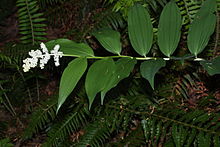- Maianthemum racemosum
-
Maianthemum racemosum M. r. subsp. amplexicaule, Squak Mountain State Park, Issaquah, Washington Scientific classification 
Kingdom: Plantae clade: Angiosperms clade: Monocots Order: Asparagales Family: Asparagaceae Subfamily: Nolinoideae Genus: Maianthemum Species: M. racemosum Binomial name Maianthemum racemosum
(L.) LinkSynonyms - Smilacina racemosa
- Vagnera racemosa
Maianthemum racemosum (Treacleberry, False Solomon's Seal, Solomon's plume[1][2] or False Spikenard; syn. Smilacina racemosa, Vagnera racemosa) is a species of flowering plant, native to North America.
It is a woodland herbaceous perennial plant growing to 50–90 cm tall, with alternate, oblong-lanceolate leaves 7–15 cm long and 3–6 cm broad. The flowers are produced on a 10–15 cm panicle, each flower with six white tepals 3–6 mm long blooming in late spring. The plants produce green fruits that are round and turn red in late summer.
It grows from cylindrical rhizomes about 0.3 m long.[2]
Contents
Distribution
Maianthemum racemosum grows in bicoastal habitats in North America up to elevations of 7,000 feet. The most robust and profuse occurrences of this plant are typically found in partial shade and deep, moist, soft soils. In the western part of North America an example typical habitat would be in a shaded ravine or riparian corridor with common understory associates of Dryopteris arguta, Trillium ovatum and Adiantum jordanii.[3]
Uses and Identification
M. r. subsp. amplexicaule fruit, Mount Baker-Snoqualmie National Forest
The young shoots, while still tender and stripped of their leaves, can be simmered in water and eaten. Their delicate flavor is somewhat reminiscent of asparagus. However, they should not be collected for this purpose unless they are obviously abundant.
Although the young shoots are edible, the plant becomes too fibrous and bitter to enjoy after it completes flowering and seed setting stages. The Ojibwa Indians harvested the roots of this plant and cooked them in lye water overnight to remove the bitterness and neutralize their strong laxative qualities.
This plant should be consumed in moderation, as it can act as a strong laxative in sensitive individuals.[citation needed] A poultice made from the roots of this plant was used as an effective treatment for sunburns by American Indians.[citation needed] The roots of this plant were often dried and then smoked by several Eastern Native American tribes as a treatment for hyperactivity in children and emotional depression.[citation needed] The plant was also used by Native Americans as a cough suppressant.[citation needed]
When young, Maianthemum racemosum may closely resemble members of the genus Veratrum, a highly toxic plant to which it is distantly related. Consequently, this plant should not be consumed unless identification is positive.[4]
-
M. r. subsp. amplexicaule, Olympic National Park
See also
- M. stellatum, also known as False Solomon's Seal
- Polygonatum biflorum, Solomon's seal
- Polygonatum commutatum, Solomon's seal
References
- ^ "Solomon's-plume (False Solomon's-seal)". Connecticut Botanical Society. http://www.ct-botanical-society.org/galleries/maianthemumrace.html.
- ^ a b "Maianthemum racemosum". Flora of North America. http://www.efloras.org/florataxon.aspx?flora_id=1&taxon_id=242101759.
- ^ C. Michael Hogan. 2008. Coastal Woodfern (Dryopteris arguta), GlobalTwitcher, ed. N. Stromberg
- ^ Gregory L. Tilford, Edible and Medicinal Plants of the West, ISBN 0-87842-359-1
External links
 Media related to Maianthemum racemosum at Wikimedia CommonsCategories:
Media related to Maianthemum racemosum at Wikimedia CommonsCategories:- Maianthemum
- Native Forbs of Ontario
- Flora of California
- Flora of Maryland
- Flora of Oregon
- Garden plants
- Medicinal plants
Wikimedia Foundation. 2010.




